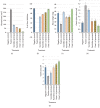Effectiveness of Opuntia ficus indica L. inermis Seed Oil in the Protection and the Healing of Experimentally Induced Gastric Mucosa Ulcer
- PMID: 31827668
- PMCID: PMC6881774
- DOI: 10.1155/2019/1568720
Effectiveness of Opuntia ficus indica L. inermis Seed Oil in the Protection and the Healing of Experimentally Induced Gastric Mucosa Ulcer
Abstract
Gastric ulcer is a painful lesion of the gastric mucosa which can be disabling, or even more very serious in the case of a perforation of the stomach and internal hemorrhage. Traditional pharmacopeias have shown the efficacy of various plant extracts in the treatment of this pathology. Some extracts from Opuntia ficus indica (OFI) have been proven to have medicinal therapeutic benefits. The aim of this study was to investigate the preventive and curative effects of OFI seed oil extracted by cold pressing on an ethanol-induced gastric ulcer model in rats. Gastroprotective activities of the oil were assessed as pretreatments prior to ethanol gavage of Wistar rats compared to reference drugs. Two oil dose effects were tested. Ulcer and gastric parameters were measured (ulcerated areas (mm2), % of ulcer inhibition, gastric juice volume and pH, and mucus weight). Macroscopical and microscopical assessments of the stomachs as well as gastric biopsy histological studies were carried out. OFI oil exhibited a high efficiency in the protection of the cytoarchitecture and function of the gastric mucosa against the severe damages provoked by ethanol intake. Ulcerated areas were very significantly reduced and the % of ulcer inhibition was the highest under OFI oil pretreatment. Mucus production was stimulated, gastric juice volume was reduced, and its pH was increased. Histopathological examination of H&E-stained biopsies collected from gastric mucosae from the different experimental groups confirmed the gastroprotective efficacy of OFI oil against ethanol-induced symptoms such as inflammation and damages like bleeding, erosions, lesions, necrosis, and ulcers. Furthermore, OFI oil treatment speeded-up the reduction of the surface of ethanol-induced ulcerated areas in a dose-dependent manner, leading to a time gain in the healing process. The healing rate reached 91% on day 2 and 99% on day 3, and a complete heal was attained at the fourth day under OFI oil treatment, while ulcer areas were still partially unhealed in all the other groups. The therapeutic effects of OFI oil against gastric ulcer could be mediated by its varied bioactive compounds that we have demonstrated in the analytical study. They could act synergistically or in a delayed manner to optimize the healing process through protective antioxidant properties, as well as an antagonism against histamine H2-receptors, a stimulation of the signaling pathways necessary for mucus and bicarbonate production, and reduction of inflammatory processes in the gastric mucosa. Additionally, OFI oil fatty acids (especially unsaturated) and triacylglycerols contribute to the reconstruction and the repair of the cell membrane lipid bilayer during the gastric ulcer healing process.
Copyright © 2019 Ikram Khémiri and Lotfi Bitri.
Conflict of interest statement
The authors declare that there is no conflict of interest regarding the publication of this article.
Figures








References
MeSH terms
Substances
LinkOut - more resources
Full Text Sources

